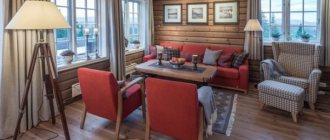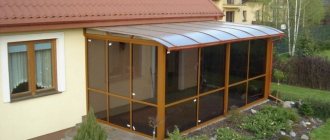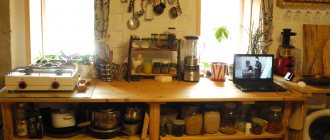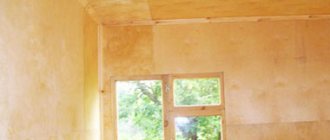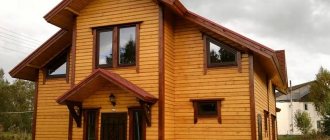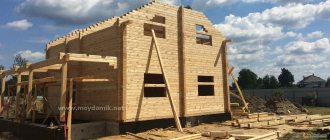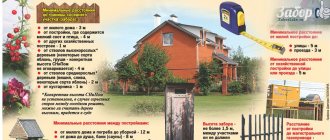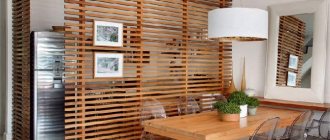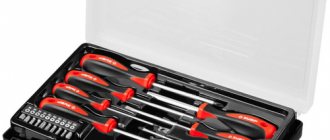Today's construction market offers finishing materials of different types and shades that can imitate any natural material. The texture is conveyed so realistically that it is difficult to distinguish artificial cladding. Imitation timber for interior decoration is made from high-quality wood, and the species does not always matter. The cladding turns out beautiful and durable.
Types of imitation timber for interior decoration
Nowadays, manufacturers use coniferous wood, less often larch, to make imitation timber. In terms of external aesthetics, the material is very similar to ordinary wooden blocks, but it has a larger width (up to 180 mm) and a small thickness. You can verify this by looking at the photo below.
Such characteristics allow you to use material economically and not eat up precious cm of room space.
The interior decoration of a house made of timber comes in two types.
Monolithic
Monolithic - this type of DIY finishing of a log house got its name due to the density and uniformity of the base cladding created with its help. It is used for walls, floors, ceilings of private houses, as in the interior in the photo below.
The main advantage of monolithic finishing is its high protective properties for the base, which is completely hidden under the cladding.
But its installation is somewhat complicated, and without certain skills, doing it yourself can be problematic;
Combined
Combined - if you started building a timber house with your own hands, you should think about combined interior decoration of rooms with imitation timber. This design has an unrivaled look, as evidenced by the photo below.
But it is used for incomplete finishing of the room, but for creating original combinations with wallpaper, ceramic tiles or textiles.
In cases where both types of imitation timber are used, it is mandatory to select decorative components that give the interior of the room logical completeness, integrity, and individual character.
This refers to all kinds of moldings, mansoles, cornices, balusters, decorative overlays, balustrades, and wood corners.
Walls
Finishing a newly built log house with timber siding cannot be done with your own hands immediately after construction is completed. The walls will need to be given enough time to shrink before work can begin. Briefly, the entire sequence of actions for finishing a log house with siding from the inside can be described as follows:
- preparatory work to clean the surface from dirt, dust and its subsequent treatment with an antiseptic;
- fastening the vapor barrier to the base using a construction stapler;
- installation of sheathing;
- installation of panels under timber;
- measures for surface treatment with protective agents.
This material on the walls allows you to create original, distinctive interiors of rooms for various purposes. More on this below. For narrow rooms, it is better to choose panels up to 100 mm wide to make the interior appear more spacious. They are mounted horizontally. And if the room has a large area but has low ceilings, it is better to mount imitation timber on the walls vertically.
How to choose the right one
While it’s easy to figure out the dimensions of the panels, it’s important not to rush in terms of selecting their other parameters. The material for the manufacture of panels is selected based on the purpose of its use and the specific microclimate in the room:
- made of larch - suitable for any interior space. Indicated for people suffering from asthma and problems with the respiratory system;
- made of oak demonstrate high resistance to moisture and mechanical stress, ideal for use in a child’s room, gym, kitchen;
- made of coniferous wood are characterized by a high resin content, therefore they should not be used in rooms with elevated temperatures (kitchen, bathhouse, bathroom).
Ceiling
Sheathing the ceiling surface with imitation timber should only begin after finishing the wall sheathing. To do this, it is worth choosing panels of a narrower width than on the walls. They are mounted on the lathing in increments of approximately 50-60 cm, placing the product the length of the room. Work begins from the window. If you want to create an accent on the ceiling, then you may prefer a different arrangement of panels. Then they will be more noticeable.
On the ceiling, imitation timber looks very natural and laconic. You can evaluate this design by looking at the photo below.
Pros and cons of finishing with imitation timber
Sheathing with imitation timber has both positive and negative aspects.
The advantages include the following:
- high sound insulation properties;
- low thermal conductivity;
- reliability and durability;
- uniqueness, originality of the drawing;
- feeling of coziness and comfort;
- relatively simple installation;
- saving money and time.
Not a single finishing material has yet had only positive qualities, and imitation timber for interior decoration is no exception.
Therefore, when making a choice in favor of this material, you need to be prepared for the following disadvantages:
- the need to constantly renew the protective layer - treat the wood with antiseptics, paint and/or varnish;
- increase the fire resistance of wood by applying special protective agents.
Paint and varnish coating
Think about the conditions that characterize the room. They will affect the nature of impregnations, protective agents and components that will be relevant for use for panels under timber:
- rooms without internal heating (dacha rooms, enclosed verandas, etc.) require the selection of timber or galvanized profiles for gypsum boards as the basis for future sheathing under the panels. Wall siding will definitely need to be treated with several layers of antiseptic impregnation and drying oil. This will allow the interior to remain resistant to negative factors for a longer time;
- a room inside a heated room allows the use of imitation timber without its careful processing and the use of special impregnations. It is enough to simply coat the panels with varnish;
- in a bathhouse, sauna, or bathroom, high humidity forms and the temperature changes sharply, so in such rooms it will be necessary to use exclusively a galvanized profile for installing imitation timber trim, as well as special compounds to protect the surface from the negative effects of moisture.
Design
Finishing for imitation timber can be of two types: monolithic and combined. It depends on the design idea.
Monolithic finishing is a complete covering of the room with imitation timber. In this case, they can cover the walls, floor and ceiling. The panels fit together very tightly, forming a single composition.
Combined finishing includes various materials. The basis is an imitation of timber, and certain areas of the room can be covered, for example, with tiles or wallpaper. The main thing is to ensure that the finishing is done in the same style and color scheme.
You can also implement original design solutions by combining different types of wood.
Regardless of the type of finish, along with imitation timber you need to purchase additional decorative elements.
These can be corners, moldings, giving individuality and completeness.
They can be made not only in the color of wood, but also in any other shade: white, black, chrome and others. These parts are presented in a wide range on the construction market.
Pricing Policy
Despite the fact that imitation timber is a specific name of the product, the price of its different options may vary significantly. The reason for this is not only the volume of packaging, but also the parameters of the boards, as well as their grade:
- “Extra” is made from wood, which may contain defects such as minor cracks at the ends, resin pockets, with dimensions not exceeding 2 cm in diameter and one point. The cost of imitation timber of this class is the highest. Most often, this material is used for interior or exterior decoration, as well as for the installation of cornice and rafter systems;
- “A/AB” is made from wood with a large number of the defects described above, as well as the presence of knots. In this case, external damage should be no more than 10% of the total surface of the element;
- “VS” , here defects such as cracks, knots and rot are allowed on the surface of the boards. Damage can cover 70% of the board surface. This material is the cheapest, but its use greatly affects the appearance of the surface being finished.
Differences between classes of boards Source nts-sk.ru
Installation
Before you begin installing imitation timber, you need to draw up a clear work plan. First of all, you should study the technology of installing panels and perform preparatory work. The base must be leveled, and the materials themselves must be impregnated with an antiseptic solution. After this, the sheathing is installed, measurements are calculated and the material is selected.
Installation should be carried out strictly following the instructions. After this, the panels are covered with protective agents.
We invite you to familiarize yourself with our range of materials
Imitation timber - Prima grade
Wood Larch Width 140 mm Thickness 20 mm Length 4 m Qty.
in pack 4 things. 2800 rub/m2
Preparation
You can sheathe a room with your own hands; to do this, you need to know the general rules and follow the technology exactly. To begin with, finishing work cannot be carried out until the cottage, cottage or country house shrinks.
If the house is frame, finishing can be done immediately after construction.
- Before installation, it is necessary to thoroughly clean the surface and level it.
- Waterproofing is carried out using mastic. For vapor barrier, the film is laid overlapping, properly attached and secured with tape.
- After this, the frame is made. The lathing made of wood must be treated with an antiseptic.
- To create thermal insulation for a room, you can use special materials, for example, mineral wool or expanded polystyrene. The layer is fixed, covered with polyethylene and treated with mounting tape.
It should be taken into account that in houses made of natural timber, thermal insulation is not necessary, but in buildings made of concrete one cannot do without it.
Safety precautions
Decorating the inside of a house with imitation timber requires compliance with the rules: “Safety in Construction”. All work related to cladding is performed in special clothing, gloves and safety glasses.
Safety in using jigsaws and other similar cutting tools is observed based on their operating instructions, which must be carefully studied before starting work.
The safety glasses presented are required to protect against splinters getting into your eyes and soft tissues. This brand and form is just one of the options that you can use
Material selection
Imitation timber is selected, first of all, depending on the type of wood, its class and the size of the panels.
There are several types of material. The “Extra” and “Premium” varieties are considered the highest quality, but they also have the highest price. Cheaper in cost are grades A, B and C.
When choosing panels, you need to take into account the uniformity of the wood texture and its color, the absence of defects on the material, the presence of knots on the surface, a certain amount of which is acceptable on budget-level panels.
When purchasing, you need to take into account not only the price category and quality of the material, but also the needs of the consumer. For example, it is not advisable to buy “Extra” class panels for finishing a bathhouse or balcony.
But in rooms where a luxurious design is planned, their use would be quite appropriate.
As for size, the range of offers on the market is very wide. Experts give some advice on this matter. For example, the large size of the panels can visually reduce the height and size of the room.
The best option may be elements with a width of 100-150 millimeters. Smaller ones will resemble cheap lining.
When choosing the length, it is necessary to take into account the surface area and decor of the room.
Imitation timber can be from 3 to 6 meters in size. The thickness should not exceed 12 millimeters.
Walls finished with panels of shorter length and thickness will not only look more profitable, but will also require less money. A thoughtful and successful combination will create a unique and unique interior of the room.
When choosing a type of wood, you need to study its qualities and characteristics.
- We can give an example of the most popular materials, one of which is larch .
This wood is highly fire resistant, very durable, and also has a very nice shade.
Larch can be used for finishing both indoors and outdoors; it can withstand even unfavorable operating conditions, and in addition, it has healing properties. Finishing with imitation timber from this wood can be carried out even in rooms with high humidity and temperature changes, such as a bathhouse and sauna.
Using linden panels you can perform work on finishing ceilings and walls. It has an even, beautiful color that tends to be preserved even with changes in temperature and humidity.
- As for oak , this tree is one of the most durable. It is resistant to rot and insects, has a large number of shades, but is very difficult to process. In addition, oak materials have a higher price compared to others.
- Aspen , on the contrary, is easy to process and resistant to high humidity. At the same time, it is not particularly durable. If the wood is properly processed and dried, over time it will develop good density and resistance to high temperatures.
However, the material has a huge drawback, which is that it may have rotten fibers inside.
This nuance cannot be detected in a timely manner; it will only reveal itself during operation. The only way out is to replace the low-quality element with a new one.
- Cedar panels have a high price, but at the same time they have excellent quality. They are durable and can easily withstand any adverse impacts.
An important point is the release of medicinal natural resins during operation.
However, it must be said that quite often cedar is counterfeited, and imitation timber based on it is made from low-quality wood, so it is worth purchasing material from trusted suppliers and checking the necessary certificates.
- pine is a fairly popular material due to its very reasonable price . It can be used in any room. The only caveat is the ability to release resin with a sharp increase in temperature.
In the case of completely finishing a house with imitation timber, you can consider combining wood species depending on preferences in price, quality, and also based on the properties and characteristics of the material.
Finishing process
The process of finishing with imitation timber consists of several stages. First you need to choose the right panels, after which you prepare the surface and install the finish.
Preparation of material
The cladding of the house from the inside is chosen in accordance with the following parameters:
- quality class B and higher;
- the optimal width of the board is 10-15 cm (too narrow elements are more reminiscent of lining rather than timber; but wide panels visually reduce the space;
- the thickness of the material is no more than 2.1 cm.
You also need to pay attention to the material used to make the boards. For warm rooms, hardwood is suitable. Linden is used for a bath or sauna, as it is not afraid of temperature changes and high humidity.
Boards for imitating panels must be dry, and before installation of the material it is stored in a dry, heated room. Before directly attaching the panels, they must be moved to the room in which the finishing is being carried out.
How to calculate the amount of material
You can calculate the total amount of material by knowing the thickness and length of the panels. To do this, you need to know the area of the room (each surface separately). Door and window openings are excluded. In this case, the total area is divided by the dimensions of one board.
The amount of wooden material must be purchased with a certain reserve. Additionally, moldings will be decorated. It is better to choose material from one batch. Before fastening, you need to carefully inspect each element. If there are knots or cracks on the boards, it is better to put them aside. They can be used partially in places hidden from view.
Preparing the surface for installation
Before attaching the imitation timber to the ceiling or walls, the base must be prepared. First, dust and debris are removed from the surface. If the walls are uneven, then putty is used to eliminate this deficiency. The wooden base is treated with antiseptic agents and fire retardants. A brick wall is primed with a deep penetration compound.
Thermal insulation and vapor barrier
Before installing the imitation, thermal and waterproofing must be installed. To prevent condensation from accumulating under the finishing, a plastic film is attached to the cleaned surface. A stapler with staples is required for fixation. If the base is concrete, then the vapor barrier is secured with sheathing bars. The entire wall area is covered with film, and it should extend 15 cm onto the ceiling and floor. The joints between the panels are sealed with construction tape.
When attaching the insulation, make sure that it is not too tight, as it may break when attaching the sheathing frame. In the absence of external thermal insulation, the insulation process is carried out from the inside before facing with the simulator. This must be taken into account when calculating the amount of facing material.
Do-it-yourself selection and installation of lathing
The choice of sheathing material depends on what the house is built from. If the structure is made of wood, then the frame bars should be the same. Their cross section is 4-5 cm. The elements are dried and treated with an antiseptic composition. For brick or concrete walls, a metal profile is more suitable.
The sheathing is fastened taking into account a step of 60-80 cm. The guide elements are fixed vertically. 2 elements are installed at once in the corners. The correct installation of vertical and horizontal frame fragments is checked using a building level.
Additionally, the places where shelves and bedside tables will be mounted are reinforced. The wiring is laid between the sheathing in a special corrugated tube that provides insulation.
How to fasten timber indoors
To cladding a frame house, you can use several fastening methods:
- Fixation in groove. The caps of the fastening elements are hidden. Self-tapping screws are screwed into the base of the tenon at an angle.
- Fastening with nails. The elements are hammered over the strip. Nails with decorative heads are suitable. To hide the fasteners, plugs are used.
- Use of clamps. In this way the cladding is attached to the wall.
Fastening the material using clamps is the best option.
Wall paneling
To secure the panels to the wall, technology is required. The work involves the following actions:
- you need to retreat 5 cm from the corner, after which the first panel is attached (all panels are installed with the tenons facing up);
- since wood tends to expand under the influence of moisture and temperature changes, a gap of 3 mm is left between the elements;
- when fixing the material in the area of windows and doors, you must strictly monitor their vertical and horizontal levels;
- installation is carried out from bottom to top;
- Lastly, ceiling and floor skirting boards are installed.
Each board is fixed at right angles to the sheathing.
Fasteners
It is preferable to secure the imitation timber using clamps. They are suitable for hidden fasteners and do not spoil the visual appearance of the surface with holes. In addition, this option is quite economical due to the low consumption of elements.
The fastening also depends on the base material.
For example, on wooden surfaces it is convenient to use self-tapping screws or nail the elements. On concrete, brick or block bases it is worth using dowels and screws.
Please note that the position of all fixed parts should be checked using a building level: in this case, the surface will be smooth and even.
Mounting features
In order for finishing using imitation timber to create a perfectly smooth surface covering, it is necessary to select the correct fastening elements. In this case, a special type of it is used - clamps. They make it possible to securely fix the boards, and at the same time they are not visible, since during installation they are covered with each subsequent panel. The dimensions of the clamps are determined based on the width and thickness of the boards. The larger these parameters are, the larger the size of the clamp should be. You can purchase clamps in separate packages of 100 or 200 pieces, where they come complete with the screws or nails necessary for fastening to the wall.
What is imitation timber
Imitation timber (IB) is a wooden cladding material, externally similar to natural timber during manufacture. This type of finishing is used for external and internal finishing of buildings.
Building an environmentally friendly house from natural wood is a very expensive pleasure.
For this purpose, professionals have invented equally environmentally friendly wooden panels that are applied to the façade of a building or the interior walls of a room, creating the impression of being built from natural wood.
Professional exterior cladding of the house with imitation timber turned an ordinary country house into an elite mansion. The picture shows that the installation followed all the rules, so there are no defects. The entire surface is varnished to protect against unpleasant external conditions.
Video description
An example of interior decoration of a house using imitation timber in the video:
And then a few more options for interesting solutions:
Combination of timber and plaster finishing
As practice shows, facade cladding can be done with different types of finishing. For example, imitation timber and plaster. The appearance of the house is distinguished by smooth lines, severity and elegance, and the resulting “striped” pattern will visually increase the height of the building.
Combined finishing of a two-story house Source betonicum-stroy.ru
Full exterior cladding of the house with imitation timber
Anyone can become the owner of such a wooden tower. The layout of the house is suitable for both active recreation and year-round living. Finishing with false beams can be done not only outside, but also inside, then your guests will definitely be able to find themselves in an old Russian fairy tale. The main thing is that the interior design matches this.
Finishing a 9x9 house with imitation timber Source www.hmkmos.ru
Timber and stone
Wood and stone go well together in decoration. This can be seen in the following project. Moreover, if in the first option the ratio “wooden covering - plaster” is approximately 1:1, and they are equally responsible for the appearance of the building, then in this case the “stone” decorations are minimal and are designed to emphasize the naturalness and superiority of wooden compositions.
Timber and stone in home decoration Source zillow.com
House with attic
Wood always remains the most environmentally friendly material. Many people strive to make it a cozy home or cottage. Here is an option for a small cottage with an attic floor. It looks like an ordinary house, but to add color, the imitation timber is painted with stain, wrought iron railings give it an intriguing look, and finishing the foundation with a stone finish completes this ensemble. This is how even an ordinary house can be turned into a small miracle of design by adding a couple of highlights.
A combination of false timber, stone and forged elements Source woodeco.org
Imitation of log walls
At first glance, it seems that the house is made of rounded logs, but, as in previous versions, this is just finishing with imitation timber. A simple way to replace expensive rounded wood, while maintaining the naturalness of the materials used, without compromising the quality of the construction project.
House project with rounded wood trim Source profibrus.ru
The cost of finishing with imitation logs depends primarily on the price of the lining that will be used for the cladding, plus the geometry of the house - the simpler it is, the less labor costs.
Size selection
This type of finishing material does not have strictly regulated dimensions. The most common products are those whose width ranges from 110 to 190 mm, and thickness from 18 to 34 mm (although there are modifications with the same thickness as lining: 14 and 16 mm).
The most popular panel thickness for interior decoration is 18-22 mm and width up to 110 mm.
If we talk about the standard version of ordinary or profiled timber, from which houses for permanent residence are built, then it has a cross-section of 150x150 mm. Therefore, the interior decoration of a house made of timber (in terms of cladding frame interior partitions) should be carried out using panels of the same width as the dimensions of the main building material.
With the choice of length, not everything is clear. There is no point in purchasing the entire batch with the same length, especially in the maximum size of six meters. Considering the length of the partitions, when covering walls inside a house, the most common panel sizes are up to four meters. It is better to calculate and select the dimensions of the molded lumber so that there are as few scraps as possible.
If the length is not enough for the entire wall, then the joints can be hidden behind furniture or hidden with a fillet.
To finish the ceiling, you need to use whole panels, if possible without splicing them along the length. And they should be located in the direction from the window (if the room is corner, then in accordance with the laying of the floorboard).
Calculation of the amount of imitation timber must be carried out not only for each room, but also for each type of surface. This will allow you to optimize the cost of materials and the cost of work in general for the interior decoration of the house.
Form of false beam
Unlike a convex blockhouse, with which false beams are often compared, it has a flat surface. Chamfers are cut along the edges at an angle of 45°. After connecting adjacent planks, barely noticeable seams remain, but not the same as with eurolining. Rather, they resemble “calm” lining.
Block house on the cut
From the back side, 1 to 3 ventilation ducts are cut out, which run along the entire length of the beam.
Reference. Previously, domestic enterprises produced wooden cladding without these grooves. This led to the fact that over time the timber became severely deformed due to temperature fluctuations, swelled, and cracks formed in the wood. The wood was susceptible to rotting due to excessive exposure to moisture.
The false block has the same lock as other types of lining
The edges of the lamellas have a spike on one side and a groove on the other. These are the connecting elements of the timber. The tongue-and-groove lock solves several problems at once:
- makes the cladding windproof;
- increases sound insulation properties;
- strengthens the skin.
Prices for various types of false beams
False beam
In which rooms can it be used?
Imitation timber is used for finishing walls and ceilings. This is a textured living material that has a number of advantages. It allows you to create the feeling of a wooden house in the interior of one or all rooms. Wood allows the coating to breathe; some varieties even purify the air.
With the help of cladding you can create a unique design and emphasize a certain style.
False timber is used to decorate the interior space of apartments, country estates, and private cottages. It will perfectly complement the corridor, living room, bedroom, nursery, office. Some breeds can be used in the bathroom, kitchen, balcony, loggia. In general, the material is universal and compatible with absolutely any room.
However, it is worth considering the fact that finishing actually reduces the usable area.
In the kitchen, using imitation timber, you can cover both the walls and the kitchen apron, but additional wood processing will be required. Different colors will highlight the severity or warmth of the space.
In the living room, it is enough to make one accent surface, or decorate a certain area, or you can completely cover all the partitions. It all depends on the preferences of the owners and style.
How to care for timber after installation work
Transparent coatings
To protect against rot, mold, sun or moisture, the outer panels must be periodically coated with solutions, varnish or wax. Wax is considered the most popular product.
Stain or varnish refreshes tarnished surfaces and returns shine - the house seems just rebuilt.
Several times a year the façade is cleaned of dirt (without using aggressive cleaning agents).
How to properly apply wax to timber
Most often, oil-wax is used to renew and protect the facade. The product is non-toxic, protects against fire, allows air to pass through, which means the wood will breathe. If desired, you can add paint to the mixture - after the wax dries, the boards will change color.
The wax should not contain benzene or aggressive solvents.
You can prepare the composition yourself: mix 2 tbsp. natural beeswax with olive oil (6-7 tsp). To make the wax soft, first melt it in a water bath and add oil.
Store the home remedy in a glass jar in the refrigerator for no more than 12 months.
Note: it is recommended to apply the product to the boards before installation, and not after it. This way all hard-to-reach areas are painted.
Before applying the layer, you need to make sure that the fasteners for simulating timber are “recessed” inward and do not stick out.
Sand the surface of the walls or ceiling with sandpaper or a sander. Check that there are no knots or potholes left (cover the defects with primer).
To prevent sandpaper particles from getting into the gaps, use coarse sandpaper.
Only after complete cleaning, treat the boards with a thin layer of wax. Remove excess with a clean, lint-free cloth.
Wax is applied to the ceiling using a roller (necessarily with a long handle), the walls can be painted with a brush with long bristles. For the floor, it is better to choose wax with a matte finish, it is not so slippery.
Wait until the product is completely dry, wipe the surface with a clean and dry cloth.
After treatment with the composition, the walls will not only shine, but will also be reliably protected from mechanical stress, and are less susceptible to rotting and mold.
The surface must be coated with a new composition every three years.
The timber simulator is ideal for facade cladding and not only “copies” a natural log, but also harmoniously combines with natural stone inserts or plaster finishes.
If you want to renovate an old wooden house for little money, then imitation timber will be the best quality material for facade cladding.
Stylistic directions
Wood is ubiquitous and has been used in construction for a long time. All cultures treat this material with respect. Therefore, natural wood finishing is compatible with almost any interior style, from country to high-tech.
However, the most related trends are eco, rustic, Provence . Here a wooden wall can become the main accent of the room.
False beams will look good in a classic interior . The classic color palette includes three main shades: beige, cream, brown. Selecting the appropriate panels is not difficult. For a Scandinavian design, the boards will have to be painted white. For country and ethnic in texture and color, oak, which has a pronounced woody pattern, is best suited.
Whitewashed and aged panels made of oak, ash, pine are appropriate for rustic and other ethnic styles .
For the loft , it is enough to decorate only the ceiling with slats or decorate a specific area. The chalet style is suitable for a country residence. There must be animal skins on the floor and walls. High-tech implies the use of wooden material only as an addition.
How to calculate material taking into account the size of the house
The calculation for purchasing the required amount of lumber is based on the purpose of the cladding: external or internal. After all, the size for these types is different:
- Width. This figure usually ranges from 110-190 mm. It is better to take wide panels for exterior decoration, narrow panels for interior decoration. Running width – 135 – 140 mm.
- Length. This size comes in 2; 2.5; 3; 5.4; 6 meters.
- Thickness. The parameters of this value can be found in the following sizes: 14, 16, 20, 22, 28, 34 mm.
- Weight. The dry square meter of the product reaches 11 kg.
The imitation timber drawing clearly shows the dimensions of the lumber. The locking system is visible on it; you can see what the groove and tenon look like. Ventilation slots that prevent the formation of condensation during operation are also schematically shown.
The most popular sizes are presented in the table below. When ordering imitation timber (be sure to look at the photo) with special dimensions, it is better to check the calculation of material consumption with the sellers.
| IB size (thickness, mm X width, mm X length, m), | Number of boards per package, pcs. | Area 1 m3/1 package |
| 20 x 140 x 6 20 x 140 x 5 20 x 140 x 4 20 x 140 x 3 20 x 140 x 2 | 5 | 68,04/4,05 59,98/3,37 50,76/2,7 39,6/2 28,08/1,35 |
| 20 x 190 x 6 20 x 190 x 5 20 x 190 x 4 20 x 190 x 3 20 x 190 x 2 | 3 | 85,47/3,33 71/2,77 60,68/2,22 48,14/1,66 34,04/1,11 |
| 25 x 190 x 6 25 x 190 x 5 25 x 190 x 4 25 x 190 x 3 25 x 190 x 2 | 3 | 67,58/4,15 56,68/3,27 41,23/2,17 40,0/1,95 27,91/1,25 |
Interior color scheme
To preserve the natural texture and color of wood, when processing panels, preference should be given to impregnations, colorless varnishes, and wax. It is better to refuse paint. In this case, the color of the board will directly depend on the type of wood. The most common shades are light brown, brown-red, and coffee.
There are also unusual ones, for example, blue, green, pink.
For clarity, let's look at some options (variety - color scheme):
- oak – from light brown to dark brown;
- beech – white with a yellowish-red tint;
- ash – from dark brown to light yellow;
- alder – red-brown;
- walnut – from light brown to black;
- pine - from pale yellow to reddish yellow;
- larch – from light yellowish to reddish;
- yew – yellowish-white.
When is it worth covering imitation with paints and varnishes?
The procedure for painting imitation timber is necessary to prevent moisture, insects and other reasons that destroy the wood. Therefore, it is necessary to cover with IB paint or varnish, especially if the external walls of the house are covered with it. Transparent and colored paint and varnish mixtures are available for sale. They treat both walls and ceilings in the same way.
Transparent mixtures include drying oil, aquolac, azure and a special composition for impregnation. The advantage of such materials is that they retain the natural color of the base wood. This coating also blocks moisture, collecting it in itself, so the wood lasts as long as possible.
Opaque paints include waterborne paints and acrylic paints. The peculiarity of such coatings is that they have different colors. You can give your cladding any shade you like.
The picture shows the varnish coating of an already assembled imitation timber structure. The procedure is usual: take wood varnish onto a brush and apply it to the surface using standard movements.
Indoor treatment and care
Natural material has some features that require special care indoors. Negative factors include susceptibility to wetting and swelling, and exposure to various microorganisms.
Deformation of timber beams can be prevented by regular treatment with special products.
Varnish coating
Water-based varnishes are well suited for treating wooden lining. They emit absolutely no odor, dry quickly, and do not contain organic solvents. Hydrophobic scuba tanks are also often used.
Impregnation repels water and provides reliable protection against rotting.
Thanks to a thin transparent film, varnishes allow you to preserve the natural color of wood. To give additional strength, polyurethane compounds are used. This coating can be applied with a brush or swab.
Coating with different types of paints
The main feature of this type of protection is the ability of the mixtures to completely hide the surface of the wood and give it a certain color. The following types of covering paints are suitable for indoor timber :
- Alkyd enamels. They have a pungent odor, emit toxic substances, and form a dense film on the surface.
- Water-dispersion paints. Completely environmentally friendly compositions, dry quickly and are quite durable.
- Polyurethane enamels. Toxic in liquid form, but resistant to mechanical damage.
Textured paint
The surface relief can be created using a wooden brush. The object is guided along the wood fibers and the soft components are destroyed. The excess is removed and varnish or paint is applied.
The effect of bleached wood is created in a similar way, but white glaze is added to the coloring composition.
Artificial aging work is carried out mechanically. They deliberately damage the surface in several places, trying to do this as naturally as possible. Then they are painted according to the standard.
How to protect a façade covered with wood from environmental influences
The structure of the timber is destroyed by the sun's rays (the surface softens, darkens and collapses).
To keep the facade in its original form, a product with ultraviolet filters is applied to the surface of the boards (at least 3 layers will be needed). But this must be done carefully - the additive can change the shade of the wood.
Constant moisture creates a favorable atmosphere for fungal growth. To protect the wood from mold, spray the facade with antiseptics. Before applying the product, clean the wood from dirt.
What types of water-repellent impregnations are there:
- In the form of a film: an invisible protective layer is formed on the boards (requires regular updating, especially on the outer facade).
- Compositions that wood absorbs into its pores. A more reliable solution.
Special chemical water-repellent solutions are diluted with water or a solvent, then the surface is treated in several layers. The composition does not affect the shade of the boards and repels water well.
In case of rotting or overgrown fungus, the surface of the timber is treated with fungicides (liquid mixed with white spirit).
The main enemies of boards are mold, mildew, moss, and insects.
A liquid based on alkyd compounds will help against insects that have already attacked the tree.
Don't forget about the fire danger.
To prevent spontaneous combustion from occurring, the surface is treated with fire retardants - substances that reduce the flammability of organic materials, slow down ignition, absorb heat and can be active or passive.
As protection, you can use not only fireproof impregnations, but also varnish, paint or enamel.
The sequence of processing the timber: first apply an anti-mold and fire agent (with fire retardants), then a water-repellent agent (water repellents), and lastly, UV protection.
Types of facade cladding with false beams:
- Solid: when the timber is mounted in the form of one monolithic wall. Thanks to the tenon-fastening system, a feeling of an ideal, continuously flat surface is created.
- With inserts of other materials. Wood can alternate with decorative tiles, wallpaper, fabric, and mosaics.
Imitation timber is often made from solid logs.
Advice: if you decide to do the interior decoration only with boards, do not take a beam that is too wide (no more than 150 mm), then the room will not seem small.
Gallery: selection of photos of imitation timber indoors
Installation methods
When covering walls, both internal and facade, you can choose horizontal or vertical methods for installing imitation timber.
Horizontally
When installing the imitation timber horizontally, place the starting board with the ridge up, then the next parts of the “lock” should be at the bottom during assembly so that no water gets into the groove.
Vertical
When vertically finishing cottages, private houses or summer cottages with imitation timber, the installation of the first board begins from the side edge of the windows to the door. The material sheathed in a vertical direction creates a smooth, ideal surface and visually expands the space in small rooms.
